ASUS Zenfone Max Review
The battery trend is on, starting from the Gionee Marathon M5, Lenovo Vibe P1 and now the ASUS Zenfone Max. The Max simply points to the maximum battery life. Having a 5000 mAh battery that also doubles as a power bank, the Zenfone Max can last long with a lot of promises from ASUS. Besides, the same internals as the ASUS Zenfone 2 Laser (Qualcomm Snapdragon 410 variant), the Zenfone Max has a grown up battery with a slight change in the aesthetics. While the battery is the main highlight here, there’s more stuff to find out in our ASUS Zenfone Max review.
In the Box
- ASUS Zenfone Max with built-in battery
- Micro USB Cable
- Power Brick
- A User Guide and a Warranty Card
- USB OTG Cable
Just like any other ASUS smartphone, the Zenfone Max doesn’t include headsets.
ASUS Zenfone Max Specifications
- Display: 5.5-inch IPS HD Display covered with Corning Gorilla Glass 4
- Software: Android 5.0.2 (Lollipop) with ZenUI
- Processor: 1.2 GHz Quad-core 64-bit Qualcomm Snapdragon 410 (MSM8916)
- GPU: Adreno 306
- Memory: 2 GB LPDDR3 RAM
- Storage: 16 GB eMMC internal storage, Expandable up to 64 GB using MicroSD, Lifetime 5 GB of free ASUS WebStorage, Free 100 GB of Google Drive Storage for 2 years.
- Main Camera: 13 MP Auto Focus with dual-tone LED flash, F2.0 aperture, Wide View, Manual Mode
- Front Camera: 5 MP Autofocus, F2.0 aperture, Wide angle 88-degree lens, 140-degree Selfie Panorama
- Connectivity: WLAN 802.11 b/g/n, Micro USB (support OTG), Bluetooth V4.0 (EDR and A2DP), Wi-Fi direct, GPS, GLONASS, AGPS & BDS
- Network: Dual Micro SIM card, 4G LTE dual-SIM (GSM + GSM), supports 4G on SIM1 and 2G/3G on SIM2
- Battery: 5000 mAh Li-Polymer (non-removable)
- Dimensions: 77.5 mm x 156 mm x 10.55 mm
- Weight: 202 grams
- Color Variant: Black and White
Design and Build
The bulky smartphone looks the same as all the ASUS Zenfones on the front yet the design is quite changed from the last generations i.e. its companion Zenfone 2 Laser. The power button on top and the volume button on the back are relocated to the right side which seems a traditional way of putting the hard buttons on the sides.
The ASUS Zenfone Max has a 5.5-inch IPS HD display, a Snapdragon 410 SoC, 16 GB storage, and other specifications used from its predecessor Zenfone 2 Laser. However, the battery under the hood is the one that has been grown a tad higher capacity and due to this, the Zenfone Max is now heavier (202 grams).
As you can see, the buttons have changed its position on the right. There is a golden colored bezel on the sides that looks like a metallic frame but it’s made up of plastic. In fact, the whole smartphone body is of plastic still on the heavier side.
Moving to the front, it has a 5 MP shooter with F2.0 aperture wide angle 88-degree lens supporting autofocus. The touch buttons on the bottom don’t light up and it is quite difficult for the people at night to navigate the buttons.
Moving towards the back, the leather-finished cover is removable, however, the 5000 mAh battery is non-removable. As the back is made of a faux leather design, it still pleases you giving a nice grip on your hands.
Moreover, it has a 13 MP autofocus camera behind with dual tone LED flash and an ASUS branding of course. Can you spot the small microphone around the camera? The infrared on the right side of the camera is used for laser focusing.
The Zenfone Max is a 4G enabled smartphone. It supports dual SIM cards. The SIM1 supports 4G network while the second SIM slot i.e. SIM2 supports 2G or 3G network. There is a Micro SD card slot to expand the storage further up to 64 GB.
On the top, it has an audio jack while on the bottom, it has a Micro USB port and a microphone. The right side has a power button and a volume control button while the left is kept empty
Display
The ASUS Zenfone Max comes with a 5.5-inch HD IPS display with a resolution of 1280 x 720p pixels protected by a Corning Gorilla Glass 4. Although some competitors use a FullHD display, ASUS used a 720 display for the battery life concerns since a low-resolution display uses less battery. The same display was spotted on the ASUS Zenfone 2 Laser.
The viewing angles are great and the image quality won’t be affected when seen from a different angle. However, the visibility under direct sunlight as well as under sunlight shade is poor hence, isn’t any great. The indoor viewing is bright enough.
Viewing Angles Are Great
Under Sunlight Shade (Left), Indoors (Right)
The colors feel natural and look decent. ASUS gives a color customization options under the display settings. It has four options – Balance, Bluelight Filter, Vivid, and Customized. You can change the color temperature from cool to warm and vice versa using the slider. The Customized option can tweak the colors using the Hue and Saturation.
Software and UI
The software on the ASUS Zenfone Max is the same, Android 5.0.2 Lollipop, not the new Android Marshmallow. On top of it has a ZenUI 2.0 skin that makes it look different from a regular Android interface. The user interface is very smooth and intuitive with so many options to customize and preinstalled apps that are useful for a smartphone user albeit some may find it bloatware.
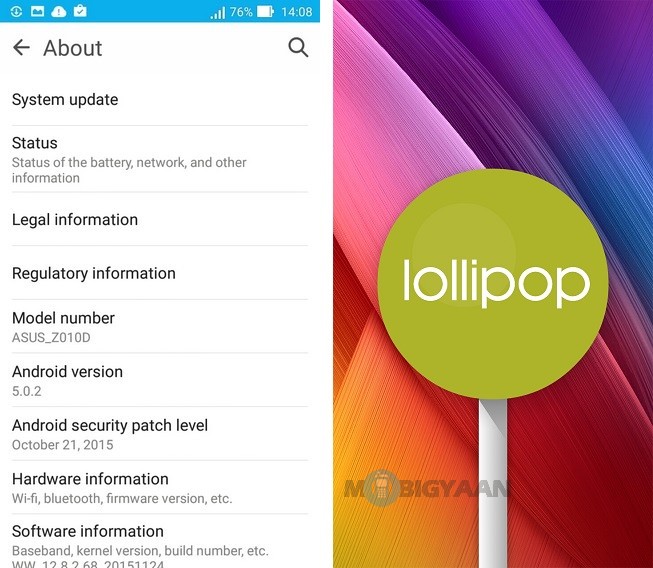
The ZenUI software skin is highly customizable and can be tweaked according to the user. The notification bar has quick shortcuts such as one tap to boost performance, autostart manager, calculator and much more. Swiping from the bottom to top on the homescreen takes you to the homescreen customization menu where you can lock apps, apply icon packs, add widgets, apply wallpapers, etc.
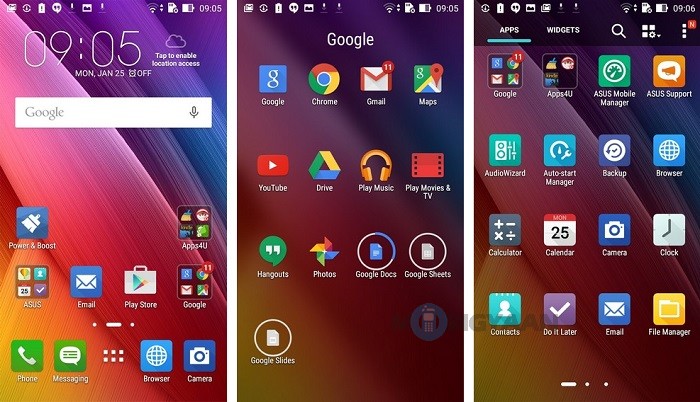

Moreover, you have the themes on the ZenUI that can be downloaded online from the preinstalled ‘Themes’ app.

Another unique app ‘Laser Ruler’ that uses your camera to measure the distance of any object using the laser autofocus.
The software also features a kids mode that lets you lock the phone using a passcode which comes handy if you hand over the smartphone to the kids.
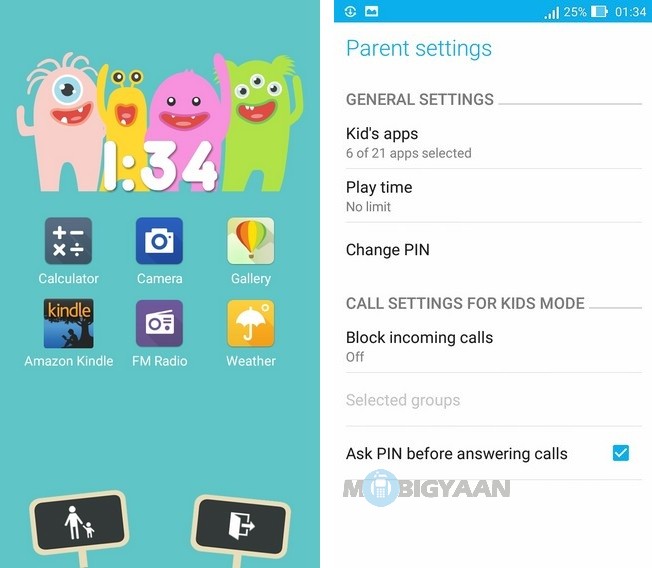
The ASUS Mobile Manager is used to handle all the things like battery saver, boosting the performance, free the RAM, virus scanning, notifications, autostart apps on boot.
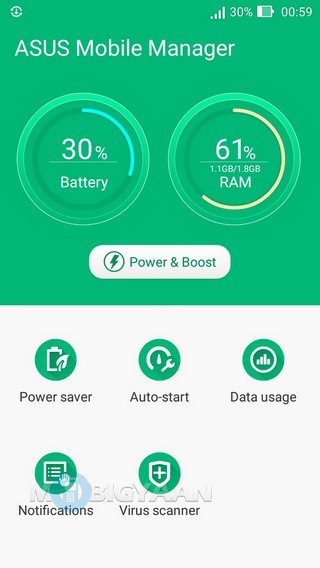
Hardware, Performance, and Gaming
The ASUS Zenfone Max is powered by a Qualcomm Snapdragon 410 SoC having a 1.2 GHz quad-core 64-bit processor along with a 2 GB of RAM and an Adreno 306 GPU. It’s the same SoC that was used in the Zenfone 2 laser hence the performance is entirely identical.
It takes around 37 seconds to boot. We ran several popular apps including WhatsApp, Facebook, Snapdeal, and Soundcloud to check the app performance and no major lagging issues found on the Zenfone Max. There are also no crash reports from the tested apps. The performance is exceptionally fluid and it doesn’t lag on the first usage. Installing too many apps can consume the RAM and you might get slight lags, however, the performance is satisfactory with the Snapdragon 410 SoC.
We ran some benchmark tests on the ASUS Zenfone Max. The AnTuTu benchmark scored 25144 points maximum during 3-pass testing. The score is close to the Coolpad Note 3 Lite (27490) yet better than the Samsung Galaxy On7 (21320).
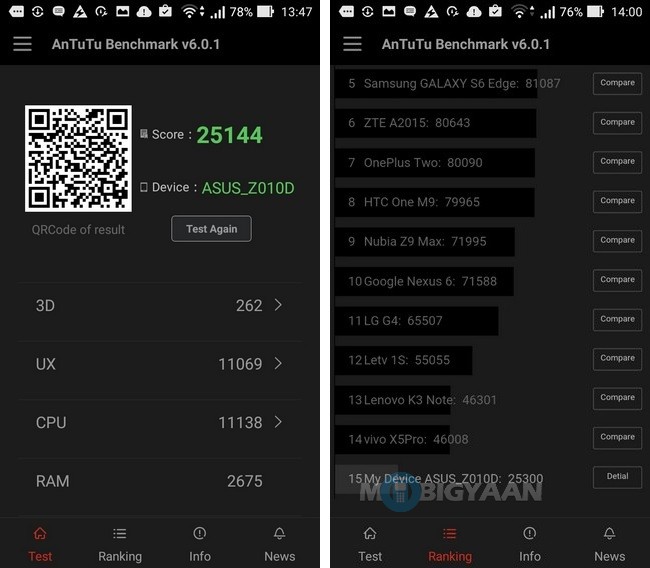
The Geekbench scored 401 points on single-core performance and 1140 points on multi-core performance. Here’s the full Geekbench 3 benchmark test of the Zenfone Max.
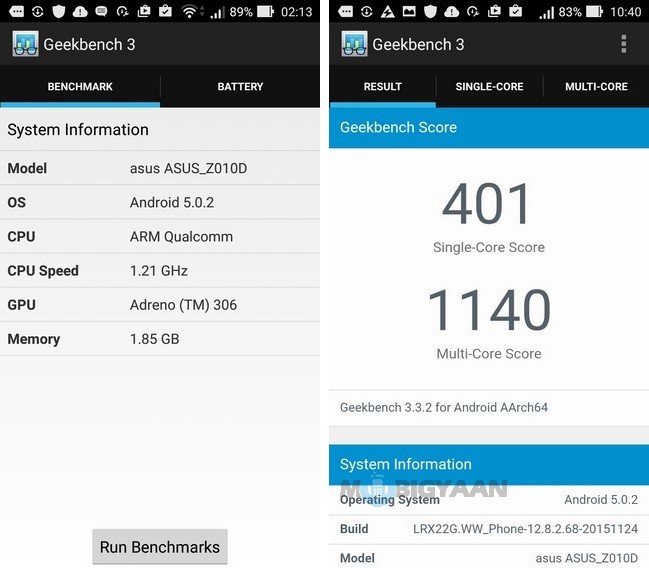
We also ran a few games to check out the gaming performance on the Zenfone Max and it turns out that the smartphone is better for an entry level gaming and somewhat good for a mainstream gaming but certainly not best for high-end gaming. The Overkill 3 had slight framerate dropouts but the other games ran fine. Games like Asphalt 8 and other heavy games may run on the phone with low graphics but not fluently.
Games Tested on ASUS Zenfone Max:
- Overkill 3
- Shadow Fight 2
- Subway Surf
- Traffic Rider
Overkill 3
Shadow Fight 2
The 2 GB RAM is sufficient for regular usage. The RAM usage on the Zenfone Max is fair. The system takes around 800 MB of RAM and the user gets around 1.2 GB free. The below screenshot shows that if there are many apps installed, the RAM usage may increase. In our case, 789 MB of free RAM was available out of 2 GB RAM.
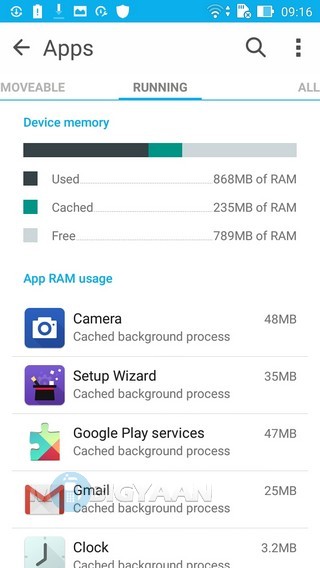
With a long duration of gaming, the Zenfone Max did not reach the 40-degree temperature. It remains cool on heavy use. The temperatures according to the HW Monitor were around 37 degrees while playing games and 30 degrees on light usage.
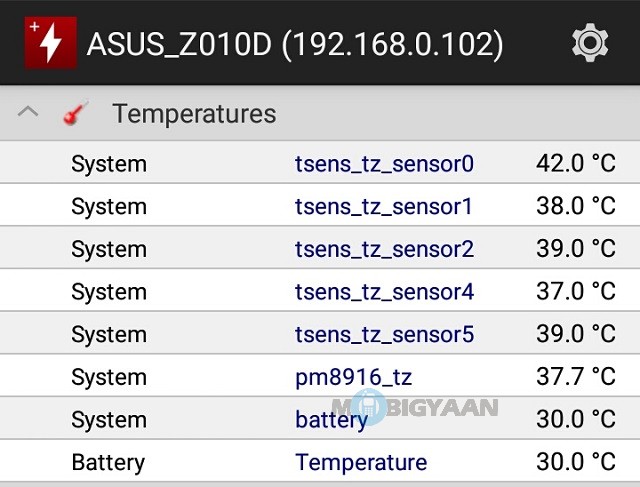
Remains Cool
Camera
The Zenfone Max sports a 13 MP F2.0 shooter with laser autofocus and many features along with a dual tone LED flash. It also features a laser focus seen on the Zenfone 2 Laser. ASUS uses their Pixel Master technology on the Zenfone Max.
The camera software features different modes such as Manual, Low Light, Depth of Field, Super Resolution, Beautification, GIF Animation, Slow Motion, Time Lapse and many more. The camera settings can be found on the settings gear icon that consists of ISO, White Balance, Exposure, and etc.
Here are the camera shots taken from the 13 MP and the 5 MP camera on the Zenfone Max.
The camera performance might be identical to the Zenfone 2 Laser or even better at some point. The main camera takes amazing shots thanks to its laser autofocus. The laser focus is fast enough focusing on objects within 0.03 seconds. The colors tend to be rich and the camera captures more details in daylight conditions but the low-light shots are filled with little noise yet decent. Some over-exposure occurs with indoor images. The good thing is the laser autofocus can focus the objects without needing the LED flash. It would be better if ASUS could have given a dedicated camera key like its flagship companion Zenfone Zoom.
The front 5 MP gives you decent shots considering that it has an autofocus which many smartphones lack in this price range. It does support some camera functions like the main camera. Overall, the 5 MP front camera fulfills the selfie requirements.





0 comments: